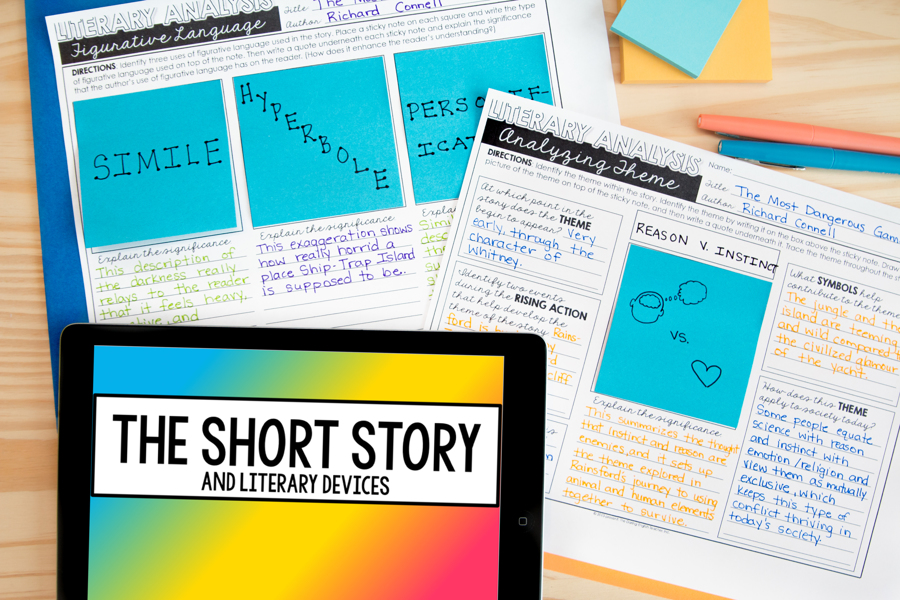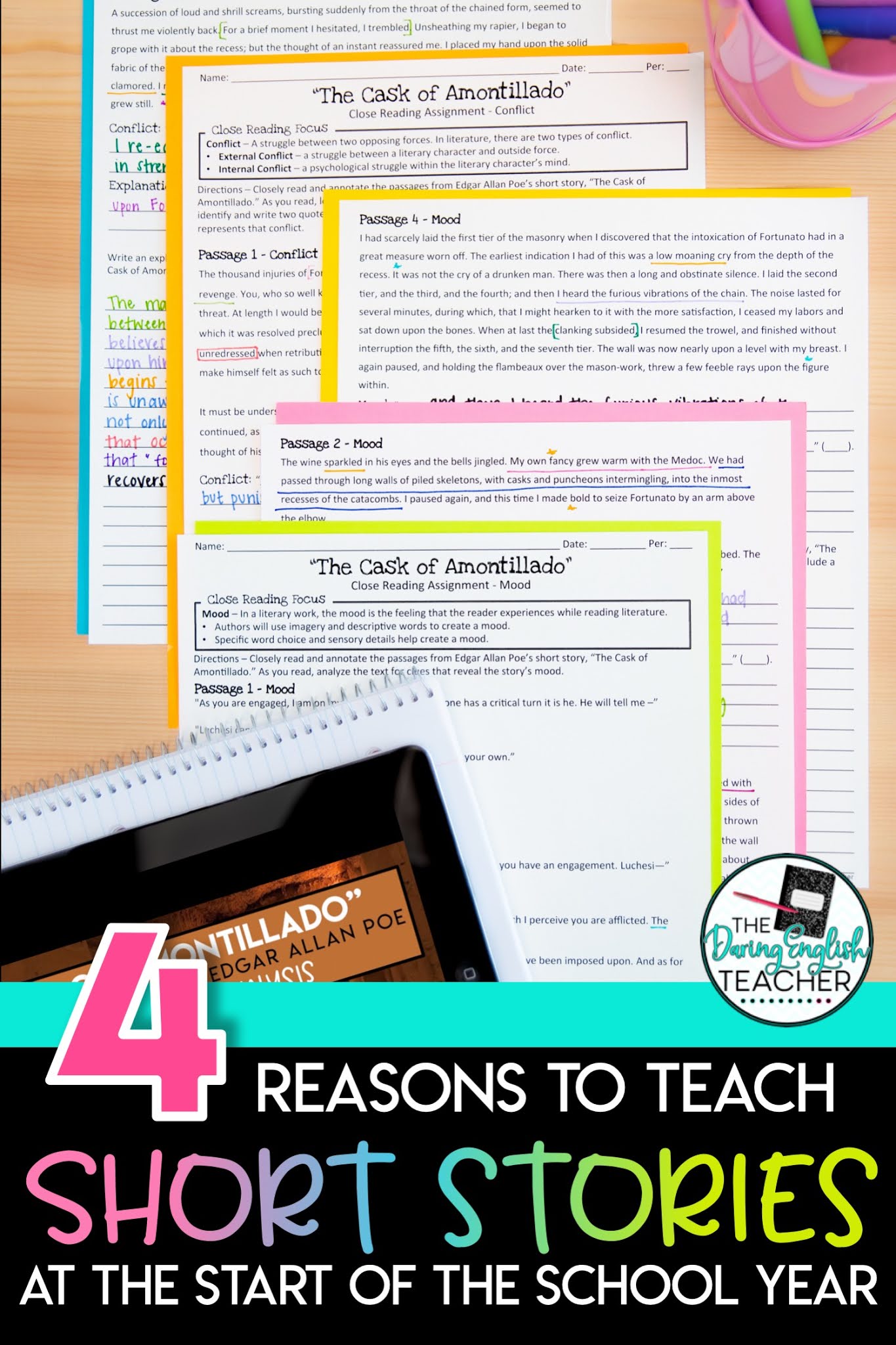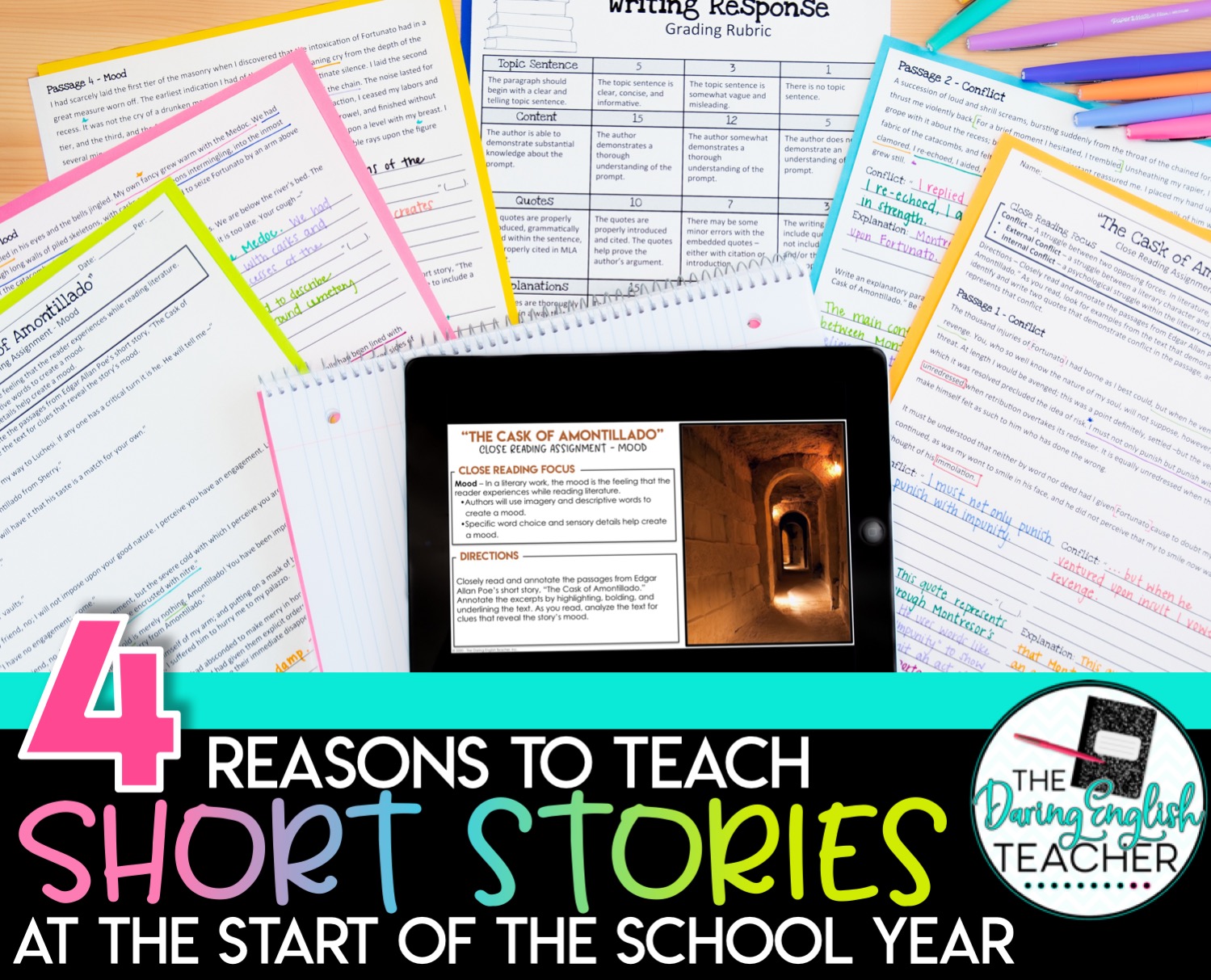Starting off the school year with teaching short stories is a great way to engage the learners in your classroom as soon as you are ready to start instruction -whether that be the very first day of school or one week into the school year after some ice-breaker and introductory activities.
 I’ve taught sophomores for more years that I can count, and every single year, I like to begin the school year and teach short stories for my first unit. In my classroom, I use my Introduction to Short Stories Unit and my Literary Analysis Sticky Note Unit for short stories, and they work really well together.
I’ve taught sophomores for more years that I can count, and every single year, I like to begin the school year and teach short stories for my first unit. In my classroom, I use my Introduction to Short Stories Unit and my Literary Analysis Sticky Note Unit for short stories, and they work really well together.
This blog post will cover four reasons why it is a smart idea to start your middle school ELA or high school English class with a short story unit.
Consider this blog post your complete guide to your beginning of the year short story unit!
Here is why teaching short stories is ideal for the start of a new school year!
Beginning of School Schedule Changes
If your school is anything like mine, the few weeks of school can have a lot of movements. Between students being transferred out of class and having new students pop up on your roster daily, the first few weeks can be a bit messy. It is difficult to start a lengthy unit or begin long-form fiction, knowing that students will miss the beginning of the unit. Because of all of the roster movement that happens at the start of a new school year, especially at a larger high school, I prefer to begin my year with short stories.
Typically, I spend one week on each short story. I provide my students with brief direct instruction at the start of the week that covers important context about the author and the story. I also use that time to introduce my students to no more than three literary elements that we will focus on for that one story.
 Then, we begin reading the story. Usually, we will spend the first two days of the story reading it and going over basic reading comprehension. Before we move on to literary analysis, I want to make sure that my students understand the story. From there, I like to spend Wednesday doing a collaborative brainstorming and analysis activity that will lead to the writing response. This is exactly how I’ve planned my short story close reading units.
Then, we begin reading the story. Usually, we will spend the first two days of the story reading it and going over basic reading comprehension. Before we move on to literary analysis, I want to make sure that my students understand the story. From there, I like to spend Wednesday doing a collaborative brainstorming and analysis activity that will lead to the writing response. This is exactly how I’ve planned my short story close reading units.
Planning my short story units this way allows me to include any new students in my classroom quite easily. If a student comes in Monday through Wednesday, they hop right into that story. If they transfer in on Thursday or Friday, I have them work on my new student survey and a quick personal narrative to help me get to know them.
I’ve structured my short story unit like this for several years now, and I’ve found that this strategy is the one that works best for me when it comes to welcoming in new students and accomodating a class roster that changes daily during the first few weeks of school.
Cover Literary Elements
In addition to easily accomodating frequent schedule changes, teaching short stories at the beginning of the school year is beneficial because I can use this time to teach and review critical literary elements with my students before we dive into our first novel. By the time we get to our first novel unit in the second quarter, I am confident that my students have a firm grasp of literary elements, literary analysis, and how to write about fiction. Having that foundational understanding is so important because then I can focus on going into more depth and adding in more complexity throughout the year.
Typically, I teach about five or six short stories in my short story unit, and with each short story, I teach and review one to three literary elements. By only focusing on a couple of literary elements with each short story, I can make sure that my students truly understand each element. By covering all of the essential literary elements at the start of the school year, I set my students up for success as we dive deeper into the curriculum. You can read more about my daily short story instruction in this blog post about teaching short stories with a close reading perspective.
Begin Writing Instruction
I’ve always found that the best type of writing instruction is the kind that seamlessly meshes with the curriculum. Starting a writing unit isn’t abrupt. Instead, it just kind of flows logically. When I teach short stories, I incorporate a writing assignment with every single short story we read. We read and brainstorm Mondays through Wednesdays, and we write on Thursdays and Fridays.
To ensure that my students learn how to write academically, I start with a short writing assignment of no more than three sentences. Yes, my sophomores only write three sentences of literary analysis at the start of the school year, but it works. You can read more about this strategy in this blog post. about three ways to boost writing instruction. This short story writing for students helps get them ready for lengthier writing later on in the school year.
By incorporating writing instruction with my short story unit, I make sure that my students are ready for more challenging academic writing later in the year. My students progress from a three-sentence response to an entire paragraph, and once they master that, they are then ready for longer essays.
Easy to Incorporate Nonfiction and Current Events
The final reason why I love teaching short stories at the start of the school year is because it is a great way to set the tone for the school year by also incorporating nonfiction and current events. The beauty of a short story unit is that there are so many different short stories to choose from. And with each short story you prefer, you can easily grab a nonfiction article or watch a current event news story that directly ties into the topic or theme of the story.
For example, one of my favorite short stories to teach is “The Seventh Man” by Haruki Murakami. It’s a longer story, and it can be a bit challenging for my sophomores, but because it centers around a typhoon, I can pull in articles and news stories about big storms, climate change, and mental health. The possibilities are endless when you make connections to the stories, and it helps open up the classroom for exciting and dynamic discussions.



2 Comments
What literary elements do you teach with short fiction? Just so I can understand your approach better! 🙂
I am about to start my student teaching next semester! I have loved reading your blog. Thank you for all your great tips and ideas.